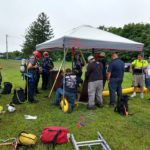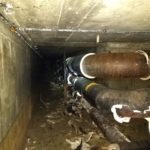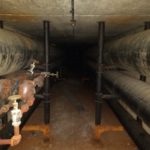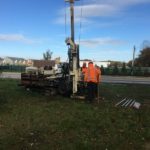A local fire district was donated a piece of property for the construction of a new firehouse to assist with the protection of a growing community. To aid the fire district prior to development, H2M’s Environmental Discipline began due diligence tasks including Phase I and II Environmental Site Assessments (ESAs). The Phase I ESA revealed several recognized environmental conditions and environmental concerns including potential asbestos containing materials and lead based paint within an underground tunnel system identified during a review of historical sources. The Phase II ESA was completed to investigate the recognized environmental conditions by completing test pits, soil borings, and installing groundwater monitoring wells. The presence and orientation of the underground tunnel system was confirmed using ground penetrating radar.
Based on the design of the new firehouse, it became apparent the location of the buried tunnels would impact the future construction of building footings. Prior to demolition activities, H2M conducted an asbestos and lead based paint survey to assess the potential for these materials to be encountered during demolition. H2M’s team developed a plan to enter the confined space under permit required confined space entry procedures so that we could assess what was inside of the discovered tunnel system. With the local fire district on standby to provide emergency rescue, H2M performed and asbestos and lead based paint investigation. Upon receiving the asbestos laboratory analysis, the Environmental and Architecture Disciplines collaborated to design an asbestos abatement specification. As part of the abatement design, it was decided to create access holes within the tunnel so that it was no longer considered a permit required confined space. This promoted teams to work faster while alleviating potential hazards associated with permit required confined space work.
Throughout the duration of the asbestos abatement H2M was on site to provide project monitoring and oversight services. Upon completion, H2M had conducted a final clearance inspection to confirm that all asbestos hazards were removed in entirety and the air quality was within re-occupancy criteria and the demolition of the rest of the tunnel and associated pipes can be discarded. This project was a collaboration of multiple disciplines within H2M, demonstrating our ability to work creatively and bring immense value to the client and local community.







